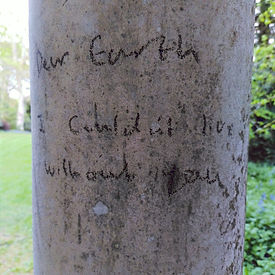Emma Yorke

Dear Earth
'Dear Earth' (1x14m) is a site specific, text-based installation made with sections of bed sheets knotted onto a wire fence which forms a field boundary on the Dartington Estate. It was installed and deinstalled on 24th May 2022 and was informed by the graffiti found in the Temple in the formal garden, which reads 'Dear Earth, I couldn't live without you'.
Referencing the fibre and knot based 'quipo' language system, which the Incan civilisation used to record and disseminate information, often related to land use and property, as well as other important data and messages, this work uses both easily legible text and also references the historical relationship between land, language and textiles which exists across temporal, country and cultural boundaries of place.
The re-presentation of the graffiti on the field boundary of one of Leonard Elmhirst's vast, 'improved' and hedgerow-less fields, recognised as the precursors of modern farming methods, can be read as foregrounding the complex history of the 'place' that is the Dartington Estate.
'Many artists take familiar sights/ sites and make them strange or legible in new ways in an attempt to undo what seems "natural", or to highlight the ideological workings of landscape... In certain cases, artworks involve "reading" the ways that the land has been marked, or used; in others, artists create new markings or material interventions, in the landscape itself. At play is an overall shift from representation towards presentation, or performance, one might say.'
(Scott and Swenson, 2015 p.4)
The use of knotted sheets opened up questions about the role of material choices in 'making meaning'. To me, the knotted sheets referenced houses on fire and narratives of climate 'disaster', but viewers of the work identified them as bandages- symbols of care and repair. This dual reading underlined the power of materials to be active collaborators in the production of meaning within the work.
The temporary nature of the work served to connect people to the impermanence of the landscape itself. As one passer-by commented during the process of de-installation - 'I am just so sad to see it go'.







